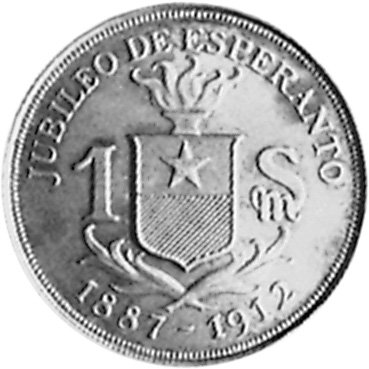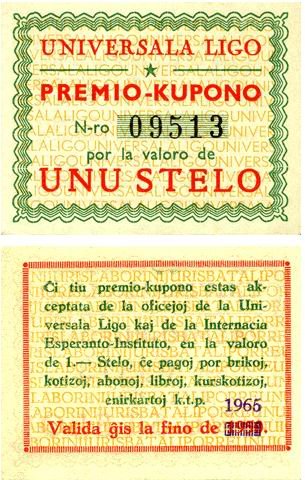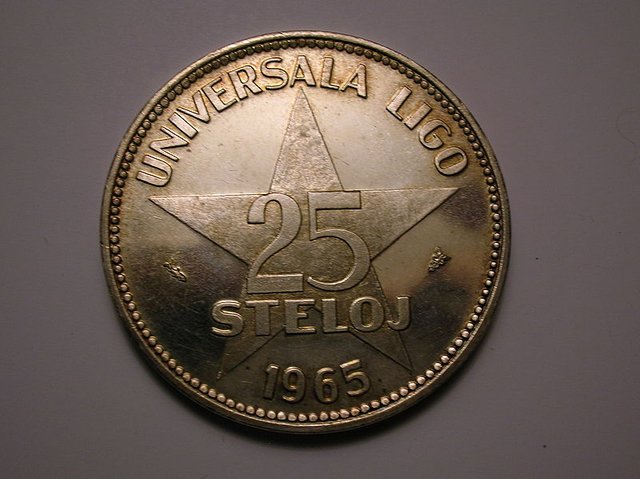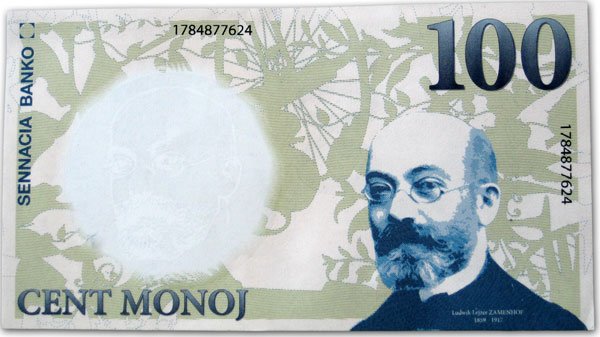Esperanto- money
Inspired by @notgeld's educating musings here on Steemit about complementary currencies I would like to shed some light on another attempt to deal with money beyond the common monetary system. I am talking about currencies created for a small community of Esperanto speakers, which aimed however to be used for global transfer.
In the end of the 19th century it became increasingly clear that the world needs to be considered as one unite and only joint efforts could solve the world's problems. International institutions popped up like The International Telecommunication Union (1865), The Universal Postal Union (1874) or The Permanent Court of Arbitration (1899). Different attempts were made to get an constructed international language working. Esperanto being the most successful of them over the years developed to an natural language spoken by some millions around the globe.
Two years after the first World Esperanto Congress in France in 1905 the mathematician Dr René de Saussure proposed a new currency called Spesemilo. It was made for international money transfer for Esperantists and issued as vouchers by few British and Swiss banks, mainly by the Ĉekobanko esperantista. The Ĉekobanko was founded in 1907 by H.F. Höveler in London with branches in Dresden and Moscow. On their checks was to read the slogan "Unu mondo, unu lingvo, unu mono" (One world, one language, one currency).
In 1914 existed 730 accounts in 320 cities in 43 countries. This currency was used until the outbreak of the First World War. One Spesmilo (from German word Spesen/expenses and milo/Esperanto thousand) was equivalent to one thousand spesoj (penny), and worth 0.733 grams of pure gold which at the time was about one Russian ruble or one-half US-dollar. On 19 January 2014, that quantity of gold would be worth about $33 U.S. dollars. The basic unit is the speso.
Today you can find Spesemilo as Unicode character (spesemilo sign U+20B7).

Silver coin issued in 1912 for the 25th anniversary of the first publication of Dr. Esperanto's International Language in 1887.
In 2011 one of the still existing four coins was auctioned for $261.
With the beginning of the First World War interest in an international currency rapidly disappeared, however after World War II with the foundation of The Universal League in the Netherlands (arm of the Esperanto movement) a new attempt was made to revive the idea of a common currency.
The new token was called Stelo (star), and used from 1945 to 1993. The Universal League issued coupons denominated in Steloj. The idea was to link the Stelo to existing currencies on the basis of relative purchasing power in different countries. The value of a Stelo would equal the price of a standard loaf of bread in the Netherlands, which at that time cost 0.25 Dutch guilders.
The League had commercial relations 3 banks in the Netherland as well as with banks in six European countries.

In 1959 real coins were minted in bronze, copper and nicle by the Royal Dutch Mint in Utrecht. They sold well so that in 1965 the League was able to issue a fourth denomination, a silver 25-Steloj coin, which also sold very well.

An interesting point about this currency is, that out of its use came an other idea. Some members of the League like Dr Roelofs believed that the Stelo should serve as the basis for international financial transactions, but only between countries that refused to deal with commercial banks. That sound quite familiar today.
However his ideas never really became reality, and with the ending of The Universal League the token disappeared too.
On a much smaller level the Stelo in a new version survived in the Esperanto movement. Nowadays exist three plastic coins 1★, 3★ and 10★. They look a bit like game money and are mostly used in meetings and congresses by younger esperantists. The value of 1 Stelo is the equvalent of one cup of tea.
In 2012 French-Danish artist Daniel Salomon issued an new currency called Mono (money) which he claims will be one day the only currency on earth. He is the director of the Sennacia Banko (Bank without nations). In a kind of art performence he not only spread his idea of a common world currency, he also gave away 100 mono paper notes, which show the picture of L.L.Zamenhof, initiator of Esperanto, on one side and a snail (a reference to the time this project needs to develope ?) on the other. The notes are beautifuly produced by a commercial currency printer in Asia.

With the appearance of cryptocurrencies, specially Bitcoin, the dream of a worldwide usable autonomous and decentralized currency could finally become true. On the Internet are a lot of discussions about this, and one enthusiast already created on the Counterparty's platform a new coin EsperantoXCP to commemorate the idea of a World´s Unique Currency. He also revived the Stelo and hopes that both will win great support.
So I am very curious to see what comes out of such initiatives. What do you think about a special token for Esperanto speakers? Would a own currency really help promoting a global language?
Ho, antaŭ nemulte mi interparolis iomete kun japana eo-parolanto pri la ebleco de ĉifrovaluto por la esperantista komunumo. Mi menciis pri la interesa influo de Monero (XMR) kaj la fakto ke ĝia nomo vere devenis de la esperanta lingvo... sed ŝajne ĝi ne rilatas al la esperanto-rondo pli ol nome.
Mi tute ne sciis ke alia kodisto jam kreis ĉifromoneron por Esperantujo. Mia scivolemo pri tio forte vekiĝis.
Dankon pro via respondo. Surprizis min, ke vi trovis mian maljunan artikolon.
Kryptomono por Esperantujo nur taŭgas, kiam ĝia apliko bone kaj facile funkcias. Eble per poŝtelefono aŭ per iu karto.
Jes, mi trovis ĉi artikolon serĉe per la etikedo esperanto.
Mi sentis ĝojon kiam eksciis ke ĉi-tie troviĝas eo-parolantoj. Ni daŭros rilatiĝante!
Bone. Koncerne monon, vi ja vidas, ke mi votis eĉ per cent percento, vi nur ricevas $0,01 steem. Tamen mi kutimiĝis voti eĉ por komentoj, se ili ne estas nur bla bla. Bonan tagon al vi!
Ho, mi ne sciis ke oni ŝatas laŭ procentoj ĉi tie. Sed mi ne trovas tiun montron pri la procentoj de la voĉdonoj. Kie ĝi videblas? Mi nur povas vidi la kvanton de personoj voĉdonintaj kaj kvanton de mono kolektita.
Kiam mi ŝatvoĉdonas por via komento mi nur rimarkas ke la alsupra butono tutverdiĝas.
Ho ve, vi ja pravas! Mi memoras, ke oni bezonas apartan sumon da SP, tiam oni aŭtomate ricevas specialan ilon por voti percente.
Sendepende de tio, ec per mia pli ol 500 SP mia voto preskaŭ ne estas rekonebla. Steemit estas kiel kutima kapitalista mondo, nur iom pli amuziga.
Parenteze, ŝati laŭ procentoj estas laŭ mi stulta afero, tamen ŝajne ne de merkata vidpunkto). Bonan tagon al vi!
Mi deziras doni al vi dankegon grandan kiel monto @johano. Multegajn dankojn pro via entuziasmiga donaco al mi!
Tiuj Steem-moneroj certe helpos min pliigi mian aktivecon ĉi tie, ĉar mi estas spertinta barojn por komenti, publikigi kaj alŝati, pro mia eta SP.
Mi povis plialtigi iomete mian Steem-potencon per miaj ĉiutagaj enspezoj el monkranoj (faucets kaj ptc's).
Denove dankon pro via helpo, ne nur mona sed ankaŭ informa, ĉar mi ne tute sciis kiel funkciis procezoj ĉi tie.
Mi ĵus publikigis mian unuan veran blogaĵon steemit-an! Mi deziris finfine fari tion por "lanĉi" mian veran agadon ĉi tie.
Same feliĉan kristnaskan tempon al vi!
Bona enhavo.
Dankon mia-sinjoro-r. Ĉu vi kutime parolas Esperanton? Ĉi tie ekzistas nur mano de esperantistoj, kiel en la reala mondo ankaŭ ni estas nur eta komunumo je steemit.